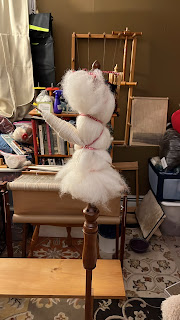The first clew.
A Clew: A ball of yarn or string, Oxford English Dictionary
My introduction to Textiles, about 35 years ago, was at The Fashion Institute of Technology as a surface design major. I loved it but I wasn’t learning about the basics of how textiles were made. I then started attending events through the Society for Creative Anachronism, in the East Kingdom, in the Crown Province of Ostgardr. I was given a brief spinning lesson from one of the citizens of Ostgardr. Spinning lead to weaving and to knitting as well. I flirted a bit with dying but haven’t gotten very far with it. In case your wondering I currently live in the Barony of Settmour Swamp
What I’m currently working on now are the following projects:
Some yard goods:
The wool warp is 5’ long, 28” wide in the reed. Breed of sheep: Targhee. Fiber prep: Carded roving. The fabric when done will be made into an Icelandic Hood as found in the book Woven Into the Earth.
Tablet Woven Garters:
Warp/weft Silk. Created for Master Lorenzo Gorla for his elevation to the Order of the Pelican, to be give to his first protégé. They will be dyed yellow then buckles attached. I have followed the instructions of Master Herveus for the design.
On going work:
Distaves!
In hand
Pole type, used with a belt
When women are shown spinning in illuminated manuscripts they are always shown using a distaff. The only illumination I’ve come across when a spinner is not using a distaff she is spinning supported using a shell as the base for her spindle. I began working with them about 10 years ago and I’m now feeling comfortable enough to teach others how to use them.
In hand spinning:
When working with a distaff the spindle is held with the tip of it in the fingers and twiddled. It’s not a supported method of spinning, nor is it dropped. I found some spinners over in England who used this method. Granny Jane had posted videos for me months ago but I could just wrap my brain aloud working this way. She was kind enough to give me a 40 minute lesson over Zoom and it finally clicked. I still need more practice but it is going a lot easier now.
Actually using a piece of my hand woven fabric:
I wove this piece of fabric over 15 years ago. There was supposed to be more of it and it would turn into a tunic for my Ex. he turned into my Ex before the fabric turned into the tunic. I’m going to use it to make a Hedeby style bag like this one found here. I have the handles for it. I just need to get off my butt and do it.
Wool Veil:
I want to spin fine merino to create a wool veil. When I’ve been reading about early English* veils the authors have spoken about finely spun/woven linen or wool but when they work with the archaeologic fines the veils are all linen. I think the main reason for this is that wool, especially finely spun/woven wools, would just have not survived all this time. I’ll still keep looking for documentation but in the mean time I’ll start spinning to create a veil.
*The term early English is a replacement for Anglo Saxon. For to long White Supremacists have used to the term Anglo Saxon to mean a white heritage based on biology. There is no such thing. The early English peoples did not call them selves Anglo Saxon. I won’t have any kind of bigotry on my blog. If anyone ever feels I am not living up to this please call me out. Show me where I went wrong. I will do my best to learn. Everyone one is welcome here!





Comments